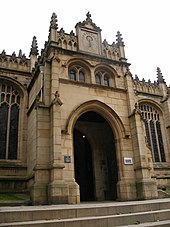Wakefield Cathedral
| Wakefield Cathedral | |
|---|---|
 Wakefield Cathedral | |
 | |
| Location | Wakefield |
| Country | England |
| Denomination | Church of England |
| Tradition | High Church |
| Website | www.wakefield-cathedral.org.uk |
| Architecture | |
| Architect(s) | George Gilbert Scott John Loughborough Pearson |
| Style | Gothic |
| Administration | |
| Province | York |
| Diocese | Wakefield |
| Clergy | |
| Bishop(s) | Rt Rev Stephen George Platten |
| Dean | Very Rev Jonathan Greener |
| Laity | |
| Organist(s) | Mr Daniel Justin |
Wakefield Cathedral, formally the Cathedral Church of All Saints Wakefield is the cathedral for the Church of England's Diocese of Wakefield and is the seat of the Bishop of Wakefield. The Cathedral has the tallest Cathedral spire in Yorkshire, and is the tallest building in the City of Wakefield.
History

The cathedral stands on the site of a Saxon church in the centre of Wakefield. Evidence of the Saxon building was discovered in 1900 when extensions to the east end of the building were made.[1] In 1090 King William II gave the church and land in Wakefield to Lewes Priory in Sussex and shortly after that a Norman church was built. Up to the 16th century the church was known by the Anglo Saxon All Hallows and after the Reformation changed to All Saints.[2] In 1888, the Diocese of Wakefield was created and All Saints church became the diocese's cathedral. Unusually, it also still serves as a parish church, meaning that until 2000 the head of the chapter of canons was called the provost, rather than the dean. In January 2000 a parish boundary change brought the chantry chapel on Wakefield Bridge into the care of the cathedral.[3]
Structure

The cathedral was built in the Perpendicular Gothic style in the early 15th century and restored to its late mediaeval appearance between 1858-1874 by Sir George Gilbert Scott in ashlar sandstone. The north aisle is the oldest part of the church, the north wall dates from about 1150. The chancel, a transept and chapel were built at the east end in 1904 to designs by John Loughborough Pearson and completed by his son, F L Pearson.
The large four stage west tower has angle buttresses and a very tall crocketed spire behind an embattled parapet with crocketed corner pinnacles and is 247 feet (75 m) tall, the highest spire in Yorkshire.[4][5] On the south wall is a porch with a sundial over the door arch.
The stained glass windows were created by Charles Eamer Kempe. In 1992 Wakefield Cathedral became only the second cathedral in Britain to form a girls' choir.
The archives of Wakefield Cathedral are held at West Yorkshire Archive Service in Wakefield.[6]
Organ and organists
Organ
The organ of 1902 built by Abbott and Smith was rebuilt by John Compton in London in 1951 - 1952. It was again rebuilt and restored by Wood of Hudderfield in 1985.[7]

Organists
There have been four organists of the Cathedral in 120 years[8], with Jonathan Bielby being the longest serving English Cathedral organist.[9]
- 1886 Joseph Naylor Hardy
- 1930 Newell S. Wallbank
- 1945 Percy George Saunders
- 1970 - 2010 (Easter Day) Jonathan Bielby
- 2010 - current Thomas Moore
Assistant organists
- William Frederick Dunnill 1896 - 1900[10]
- John George Haigh
- John Scott
- Peter David Gould 1975 - 1983
- Gareth Green 1983 - 1985[11]
- Keith Wright 1985 - 1991
- Sean Farrell 1991 - 1997
- Louise Reid 1997 - 2002
- Thomas Moore 2002 - 2010[12]
- Daniel Justin 2010 - current
The Wakefield Cathedral Choir, directed by Thomas Moore and assisted by Daniel Justin(The acting assistant director of music and assistant organist), consists of boys, girls and men who perform at the cathedral and have appeared on BBC One's Songs of Praise and BBC Radio 3's Choral Evensong.[12]
2005 Maundy Money Ceremony
In 2005, Queen Elizabeth II visited the cathedral for the Maundy money Ceremony.
-
Yeomen of the Guard marching
-
Prince Philip holding the door for Queen Elizabeth II, walking towards the provost
References
- Notes
- ^ Walker 1966, p. 172
- ^ Walker 1966, p. 169
- ^ Warburton & Taylor 2006, p. 21
- ^ Wakefield Cathedral, History & Architecture, retrieved 2010-09-04
{{citation}}: Unknown parameter|Publisher=ignored (|publisher=suggested) (help) - ^ Wakefield Council - Wakefield Cathedral, Wakefield Council, retrieved 2010-09-04
- ^ West Yorkshire Archives, WYJS, ISBN 1870453115, retrieved 2010-03-15
- ^ National Pipe Organ Register, NPOR, retrieved 2010-03-15
- ^ Cathedral Music Links
- ^ www.bbc.co.uk Songs of Praise: Factsheet 20 January 2008
- ^ 20th Century Cathedral Organists. Enid Bird
- ^ Horsforth Music Festival 2008 Music adjudicator
- ^ a b Cathedral choir, wakefieldcathedral.org.uk, retrieved 2009-11-20
- Bibliography
- Nairn-Briggs, G., Wakefield Cathedral, Jarrold Publishing, ISBN 978-0-7117-4228-4
- Sisson, Joseph Lawson (1824), Historic sketch of the parish church, Wakefield, Richard Nichols
- Walker, J.W. (1966), Wakefield its History and People Vol.1&2 3rd Edn, S.R. Publishers
- Warburton, Malcolm; Taylor, Kate (2006), Sue Robinson (ed.), Wakefield Cathedral, Jarrold, ISBN 978-0-7117-4228-4


